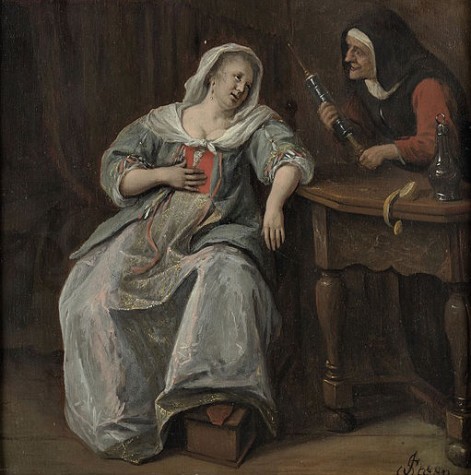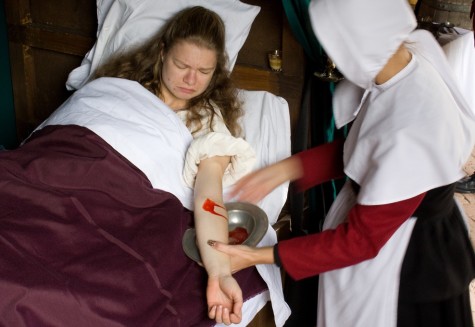Have you ever read a book where someone had pleurisy, or gout, or hysteria, and wondered…how come I never hear about anybody getting that anymore? Well, you’re in luck: It’s Outmoded Diseases Week at LWON, and we’re going to tell you. About some of them, anyway.

I stumbled into the commute van in the dark, feeling for where to put my pack. It was 5:56 am in late January. The van was habitually punctual and the other riders raised their eyebrows if it was two minutes late.
The last one in, I scrambled into my seat. But as I leaned against the seat back, a searing pain made me catch my breath. What? That was weird. I dropped my knapsack, heavy with papers and my work laptop and reached for the seatbelt to buckle myself in. Another stab of pain. I clenched my teeth and tried not to whimper. I must have pulled a muscle.
But the pain was in a strange place, on the left side of my back just behind my heart.
As the van lurched across an intersection and onto a dark freeway onramp, I tried breathing into the pain gently but firmly. Agonizing. I switched to taking lots of shallow breaths and trying not to move despite the bouncing van. Over the next 45 minutes of my ride to work I discovered that if I twisted to one side and wedged the painful spot firmly against the back of the seat, I could breathe with just minor pain, as long as I took tiny breaths.
The van jolted to a stop; I grabbed my pack, opened the door, and tumbled out into the cold dawn. As I walked up the sidewalk to my office, I shut my eyes against the pain. This was crazy. What had happened to me?
At work in a medical school communications office, I read about chest pain. I didn’t think I was having a heart attack. But it hurt every single time I took a breath. It turns out we breathe quite frequently. Oh, yes. And if you try not to breathe much, you will, willy nilly, suddenly find yourself taking a deep breath when you are thinking about something else, like where to break a paragraph.
I called Kaiser and made an appointment. Two buses and a four-block walk later, I arrived in the clinic dizzy and panting. All I could think about was breathing, and not in the Yoga or meditation way.
The 40-foot walk to the exam room winded me. Apparently intrigued, my doctor made me walk it again so she could watch me gasp. She frowned.
Probably not a heart attack, she said, but she was concerned and wanted me to get an X-ray and a blood test to rule out pulmonary embolism, heart attack, and pneumonia. She said she was leaning towards pleurisy.
Pleurisy? Wasn’t that one of those Victorian diseases people got in the 1880s, arms resting beautifully against moist foreheads? Well, yes, but it turns out that in the U.S. as many as a million and a half people still get pleurisy every year.
Pleurisy is an inflammation of the pleura — two thin sacks that encase the lungs and allow the lungs to expand and contract smoothly. Imagine stuffing a lung into a rubber balloon, smearing the outside with lubricant and then stuffing that into another balloon. When the lung expands, the inner balloon expands smoothly against the outer one.
Unless you have pleurisy. And then every time you take a breath the two pleural membranes rub painfully against one another. And each rub inflames them more. Usually it starts with a viral infection, pneumonia or tuberculosis. I hadn’t been sick at all when the pleurisy struck.
My doctor’s office was closing, so Dr. Cherukuri sent me to a hospital for the tests. She ordered me a $50 ambulance, cheaper than a taxi in Silicon Valley and they gave me oxygen, which Uber doesn’t offer. The ER doctor eventually declared me heart-attack and pulmonary-embolism–free and said I could go home with my pleurisy. She said to take anti-inflammatories and call my regular doctor if it didn’t go away.
My kind-hearted, twenty-something son left work early to come rescue me and take me home. I stayed in bed and took anti-inflammatories. Gradually, it hurt less to breathe. But after two weeks I was still short of breath and exhausted. And I had developed a relentless cough. Breathing was my new avocation; coughing a passionate hobby.
If I’d lived in colonial Williamsburg and had a good doctor, he would have been bleeding me. I know that because in 1740 John Tennent, MD, of Williamsburg wrote a 36-page Essay on the Pleurisy.
Tennent argued that pleurisy was caused by the blood becoming too viscous, with choice explanations such as: “’Tis well know, that a hot or warm Air has not that Force in raifing the Globules of Blood in the Lungs, by which it is rendered fluid, and hindred from fubfiding, as that which is cold, becaufe of the greater Denfity of the latter. . .”
He said that viscous blood stagnates in the pleura. “Thus, the Lungs, or Pleura, or both at once, are from this Cause, and in this manner, stuffed with Blood, whence proceed the Inflammation and Symptoms of the Distemper, viz. Difficulty in Breathing, Pain of the Side and Breath, Cough, and Fever.”
Dr. Tennent could have diagnosed me perfectly. But bloodletting? There had to be another way.

I contacted my doctor to see if maybe she’d forgotten to tell me something. She didn’t seem to think so.
Despite the fancy tests at the hospital, the only modern care I was getting was a very effective anti-inflammatory. But by three weeks I was getting sicker and had developed a fever that lasted five days.
Tennent recommended against emetics because vomiting when you have pleurisy really hurts and promotes more inflammation of the pleura. He didn’t think much of Fomentations or Liniments either, and recommended against opiates in the beginning of the disease as they would “certainly fuffocate the Patient.” He said opiates were okay to use to treat the cough that comes later, but only in “good hands.”
“Bloodletting is evidently of great service in the beginning of the disease,” on account of it thinning the blood. “Let the patient first have 10 ounces of blood taken from the arm or foot . . . to be repeated the second day.” If that doesn’t provide relief in the first day or two, he went on rather casually, the patient is probably going to die anyway.
I contacted my doctor and demanded modern medical care.
Dr. Cherukuri laughed cheerfully and gave me cough syrup — with codeine — and an antibiotic. Within a week I was upright. I coughed for a few more days but that was it. It’s been a month since I survived the pleurisy without a proper bloodletting. I’m so happy to be in Dr. Cherukuri’s good hands and not Dr. Tennent’s.
***
First image courtesy of Wikimedia
Second Image courtesy of Hans Splinter at Flickr
I’ve had Pleurisy. It came on fast and was extremely painful to breathe. It wasn’t until I started coughing up bile we knew I needed modern medicine and quickly.
I wouldn’t call Pleurisy that outmoded a disease. I’ve known several people who have had it. The first doctor probably didn’t give you antibiotics right away because of the lack of cough. Most folks I’ve known, the cough was there early in the illness.